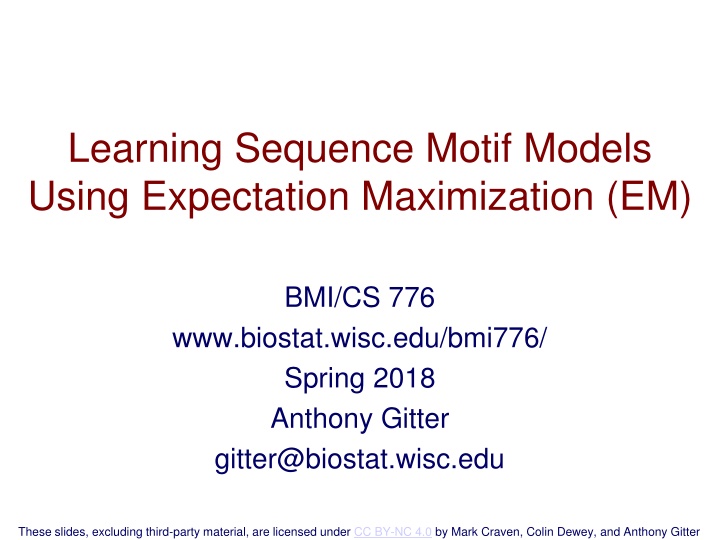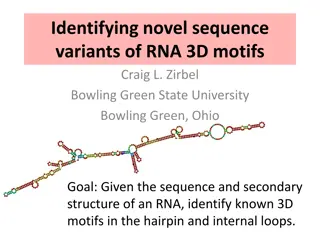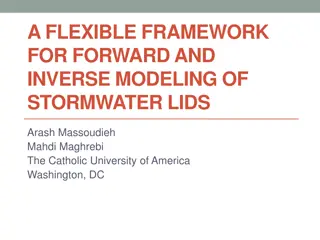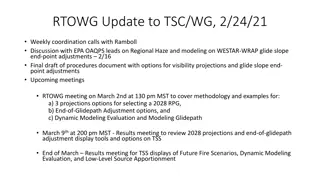
Sequence Motif Models with Expectation Maximization
Explore the concept of sequence motifs, their significance in biology, and learn how Expectation Maximization (EM) is used to address motif finding problems. Discover motif models, profile matrices, and sequence logos for inferring and predicting motif occurrences in biological sequences.
Download Presentation

Please find below an Image/Link to download the presentation.
The content on the website is provided AS IS for your information and personal use only. It may not be sold, licensed, or shared on other websites without obtaining consent from the author. If you encounter any issues during the download, it is possible that the publisher has removed the file from their server.
You are allowed to download the files provided on this website for personal or commercial use, subject to the condition that they are used lawfully. All files are the property of their respective owners.
The content on the website is provided AS IS for your information and personal use only. It may not be sold, licensed, or shared on other websites without obtaining consent from the author.
E N D
Presentation Transcript
Learning Sequence Motif Models Using Expectation Maximization (EM) BMI/CS 776 www.biostat.wisc.edu/bmi776/ Spring 2018 Anthony Gitter gitter@biostat.wisc.edu These slides, excluding third-party material, are licensed under CC BY-NC 4.0 by Mark Craven, Colin Dewey, and Anthony Gitter
Goals for Lecture Key concepts the motif finding problem using EM to address the motif-finding problem the OOPS and ZOOPS models 2
Sequence Motifs What is a sequence motif ? a sequence pattern of biological significance Examples DNA sequences corresponding to protein binding sites protein sequences corresponding to common functions or conserved pieces of structure 3
Sequence Motifs Example CAP-binding motif model based on 59 binding sites in E.coli helix-turn-helix motif model based on 100 aligned protein sequences Crooks et al., Genome Research 14:1188-90, 2004. 4
The Motif Model Learning Task given: a set of sequences that are thought to contain occurrences of an unknown motif of interest do: infer a model of the motif predict the locations of the motif occurrences in the given sequences 5
Why is this important? To further our understanding of which regions of sequences are functional DNA: biochemical mechanisms by which the expression of genes are regulated Proteins: which regions of proteins interface with other molecules (e.g., DNA binding sites) Mutations in these regions may be significant 6
Motifs and Profile Matrices (a.k.a. Position Weight Matrices) Given a set of aligned sequences, it is straightforward to construct a profile matrix characterizing a motif of interest shared motif sequence positions 1 2 3 4 5 6 7 8 0.1 0.3 0.1 0.2 0.2 0.4 0.3 0.1 A 0.5 0.2 0.1 0.1 0.6 0.1 0.2 0.7 C G 0.2 0.2 0.6 0.5 0.1 0.2 0.2 0.1 T 0.2 0.3 0.3 0.1 0.2 0.2 0.1 0.3 Each element represents the probability of given character at a specified position 7
Sequence Logos 1 2 3 4 5 6 7 8 0.1 0.3 0.1 0.2 0.2 0.4 0.3 0.1 A 0.5 0.2 0.1 0.1 0.6 0.1 0.2 0.7 C G 0.2 0.2 0.6 0.5 0.1 0.2 0.2 0.1 T 0.2 0.3 0.3 0.1 0.2 0.2 0.1 0.3 or frequency logo information content logo 8
Motifs and Profile Matrices How can we construct the profile if the sequences aren t aligned? In the typical case we don t know what the motif looks like. 9
Unaligned Sequence Example ChIP-chip experiment tells which probes are bound (though this protocol has been replaced by ChIP-seq) Figure from https://en.wikipedia.org/wiki/ChIP-on-chip 10
The Expectation-Maximization (EM) Approach [Lawrence & Reilly, 1990; Bailey & Elkan, 1993, 1994, 1995] EM is a family of algorithms for learning probabilistic models in problems that involve hidden state In our problem, the hidden state is where the motif starts in each training sequence 11
Overview of EM Method for finding the maximum likelihood (ML) parameters ( ) for a model (M) and data (D) = argmax ( | , ) P D M ML Useful when it is difficult to optimize directly likelihood can be decomposed by the introduction of hidden information (Z) Z ( | ) P D = ( | ) ( , | ) P D P D Z and it is easy to optimize the function (with respect to ): Z = t t ( | ) ( | , ) log ( , | ) Q P Z D P D Z (see optional reading and text section 11.6 for details) 12
Applying EM to the Motif Finding Problem First define the probabilistic model and likelihood function Identify the hidden variables (Z) In this application, they are the locations of the motifs Write out the Expectation (E) step Compute the expected values of the hidden variables given current parameter values Write out the Maximization (M) step Determine the parameters that maximize the Q function, given the expected values of the hidden variables ( | ) P D 13
Representing Motifs in MEME MEME: Multiple EM for Motif Elicitation A motif is assumed to have a fixed width, W represented by a matrix of probabilities: pc, k represents the probability of character c in column k Also represent the background (i.e. sequence outside the motif): pc,0 represents the probability of character c in the background Data D is a collection of sequences, denoted X 14
Representing Motifs in MEME Example: a motif model of length 3 0 1 2 3 A 0.25 0.1 0.5 0.2 C 0.25 0.4 0.2 0.1 G 0.25 0.3 0.1 0.6 T 0.25 0.2 0.2 0.1 = p motif positions background 15
Representing Motif Starting Positions in MEME The element Zi,jof the matrix Z is an indicator random variable that takes value 1 if the motif starts in position j in sequence i (and takesvalue 0 otherwise) Example: given DNA sequences where L=6 and W=3 Possible starting positions m = L W + 1 = Z 1 2 3 4 seq1 0 0 1 0 seq2 1 0 0 0 seq3 0 0 0 1 seq4 0 1 0 0 G T C A G G G A G A G T A C G G A G C C A G T C 16
Probability of a Sequence Given a Motif Starting Position j + j W 1 L + 1 1 j j W L = k = k = j = = ( | , 1 ) P X Z p p p p + , 0 , , 1 0 , i i j c c k j c k k k + 1 j k W before motif motif after motif X is the ith sequence i i Z, is 1 if motif starts at position j in sequence i j kc is the character at position k in sequence i 17
Sequence Probability Example = X G C T G T A G i 0 1 2 3 A 0.25 0.1 0.5 0.2 C 0.25 0.4 0.2 0.1 G 0.25 0.3 0.1 0.6 T 0.25 0.2 0.2 0.1 = p = = p ( | , 1 p ) P X Z p 3 , i i = p p p p p G,0 C,0 T,1 G,2 T,3 A,0 G,0 . 0 2 . 0 1 . 0 1 . 0 . 0 . 0 . 0 25 25 25 25 18
Likelihood Function EM (indirectly) optimizes log likelihood of observed data log P ( | ) X p M step requires joint log likelihood = log ( , | ) log ( , | ) P X Z p P X Z p i i i = log ( | , ) ( | ) P X Z p P Z p i i i i Z = = log ( | , 1 ) P X Z p 1 , i j , i i j m i j = = + log ( | , 1 ) log Z P X Z p n 1 , , i j i i j m i j See Section IV.C of Bailey s dissertation for details 19
Basic EM Approach given: length parameter W, training set of sequences t=0 set initial values for p(0) do ++t re-estimate Z(t) from p(t-1)(E-step) re-estimate p(t) from Z(t)(M-step) until change in p(t) < (or change in likelihood is < ) return: p(t), Z(t) 20
Expected Starting Positions During the E-step, we compute the expected values of Z given X andp(t-1) We denote these expected values For example: G C T G T A G C T G T A G C T G T A G C T G T A ) 1 = ( ) ( t t [ | , ] Z E Z X p indicator random variable expected value at iteration t 1 2 3 4 seq1 0.1 0.1 0.2 0.6 seq2 0.4 0.2 0.1 0.3 seq3 0.3 0.1 0.5 0.1 = (t ) Z 21
The E-step: Computing Z(t) To estimate the starting positions in Z at step t = = ( ) 1 t ( | , 1 ) ( ) 1 P X Z p P Z , , i i j i j = ( ) t Z , i j m = k = = ( ) 1 t ( | , 1 ) ( ) 1 P X Z p P Z , , i i k i k 1 This comes from Bayes rule applied to ) 1 | 1 = ( t ( , ) P Z X p , i j i 22
The E-step: Computing Z(t) Assume that it is equally likely that the motif will start in any position ) 1 = = i Z ( P 1 , j m = = ( ) 1 t ( | , 1 ) ( ) 1 P X Z p P Z , , i i j i j = ( ) t Z , i j m = k = = ( ) 1 t ( | , 1 ) ( ) 1 P X Z p P Z , , i i k i k 1 23
Example: Computing Z(t) = X G C T G T A G i 0 1 2 3 A 0.25 0.1 0.5 0.2 C 0.25 0.4 0.2 0.1 G 0.25 0.3 0.1 0.6 T 0.25 0.2 0.2 0.1 ) 1 = (t p ) 1 = = 2 . 0 25 1 . 0 2 . 0 4 . 0 . 0 . 0 . 0 . 0 . 0 . 0 . 0 ( ) ( t t ( ( | | , 1 , 1 = ) ) 3 . 0 . 0 = 25 6 . 0 25 25 25 25 25 25 Z Z P P X X Z Z p p ... i 1 , i 1 , i ) 1 ( ) ( t t i 2 , i 2 , i m = j Then normalize so that = ( ) t 1 Z , i j 1 24
The M-step: Estimating p cp, Recall represents the probability of character c in position k; values for k=0 represent the background + = , ( T G C A b k n d , , c k n c k d ( c ) k t p , , + ) pseudo-counts , b k b k { , , } i j { ( ) t 0 Z k , i j = | } X c + , 1 i j k sum over positions where c appears = n W , c k = j = 0 n n k , c c j total # of c s in data set 1 25
Example: Estimating p A C A G C A , 7 . 0 , 1 . 0 2 , 1 1 , 1 = = Z = = ( ) ( ) ( ) ( ) t t t t , 1 . 0 1 . 0 Z Z Z 3 , 1 4 , 1 A G G C A G , 4 . 0 1 , 2 = Z = = = ( ) ( ) ( ) ( ) t t t t , 1 . 0 , 1 . 0 4 . 0 Z Z Z 2 , 2 3 , 2 4 , 2 T C A G T C , 2 . 0 1 , 3 = Z = = = ( ) ( ) ( ) ( ) t t t t , 6 . 0 , 1 . 0 1 . 0 Z Z Z 2 , 3 3 , 3 4 , 3 + Z + + + ( ) ( ) ( ) ( ) t t t t 1 + Z Z Z Z 1 , 1 + 3 , 1 1 , 2 t 3 , 3 t = ( ) t p A,1 + + ( ) ( ) ( ) ( ) t t ... 4 Z Z Z 1 , 1 2 , 1 3 , 3 4 , 3 + Z + + + ( ) ( ) ( ) ( ) t t t t 1 + Z Z Z Z 1 , 1 + 4 , 1 3 , 2 t 1 , 3 t = ( ) t p C,2 + + ( ) ( ) ( ) ( ) t t ... 4 Z Z Z 1 , 1 2 , 1 3 , 3 4 , 3 26
The ZOOPS Model The approach as we ve outlined it, assumes that each sequence has exactly one motif occurrence per sequence; this is the OOPS model The ZOOPS model assumes zero or one occurrences per sequence 27
E-step in the ZOOPS Model We need to consider another alternative: the ith sequence doesn t contain the motif We add another parameter (and its relative) prior probability of a sequence containing a motif prior probability that any position in a sequence is the start of a motif = = + ( ) 1 L W m 28
E-step in the ZOOPS Model = ( ) 1 ( ) 1 t t ( | , 1 ) P X Z p , i i j = ( ) t Z , i j m = k = + = ( ) 1 ( ) 1 ( ) 1 ( ) 1 t t t t ( | , 0 )( 1 ) ( | , 1 ) P X Q p P X Z p , i i i i k 1 Qiis a random variable for which Qi= 1 if sequence Xicontains a motif, Qi = 0 otherwise m = j = Q Z , i i j 1 L = j ) 1 = = ( = = t ( ) 1 ( ) 1 t t ( ) 0 1 P i Q ( | , 0 ) P X Q p cp i i 0 , j 1 29
M-step in the ZOOPS Model Update p same as before Update as follows: 1 n = i = ( ) ( ) ( ) t t t m Q i n 1 30
Extensions to the Basic EM Approach in MEME Varying the approach (TCM model) to assume zero or more motif occurrences per sequence Choosing the width of the motif Finding multiple motifs in a group of sequences Choosing good starting points for the parameters Using background knowledge to bias the parameters 31
Starting Points in MEME EM is susceptible to local maxima, so it s a good idea to try multiple starting points Insight: motif must be similar to some subsequence in data set For every distinct subsequence of length W in the training set derive an initial p matrix from this subsequence run EM for 1 iteration Choose motif model (i.e. p matrix) with highest likelihood Run EM to convergence 32
Using Subsequences as Starting Points for EM Set values matching letters in the subsequence to some value Set other values to (1- )/(M-1) where M is the length of the alphabet Example: for the subsequence TAT with =0.7 1 2 3 A 0.1 0.7 0.1 C 0.1 0.1 0.1 G 0.1 0.1 0.1 T 0.7 0.1 0.7 = p 33
MEME web server http://meme-suite.org/ 34






















